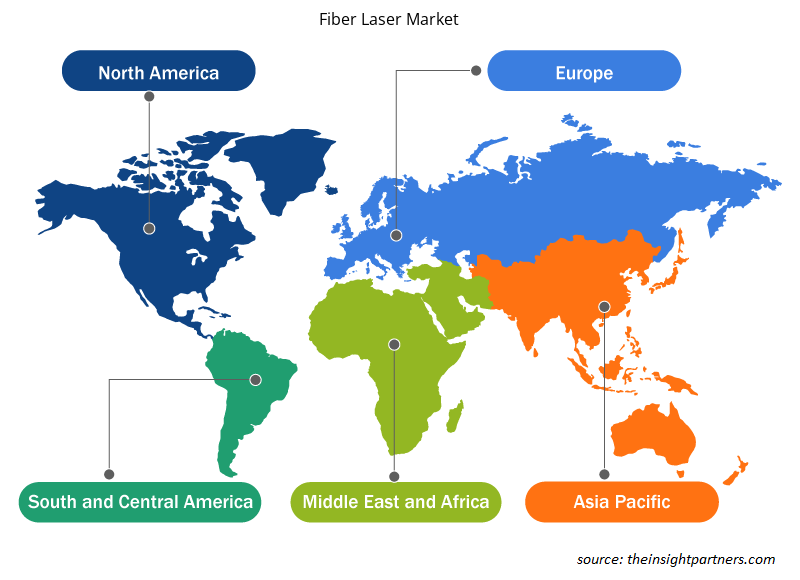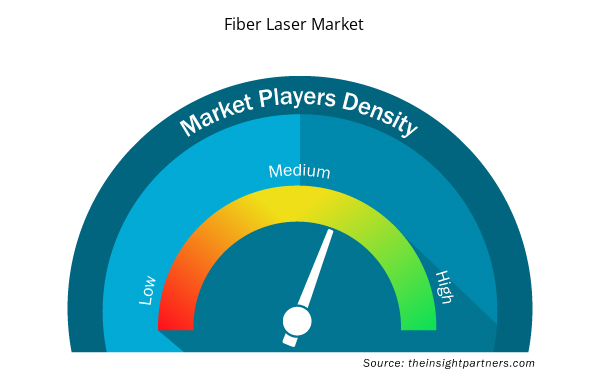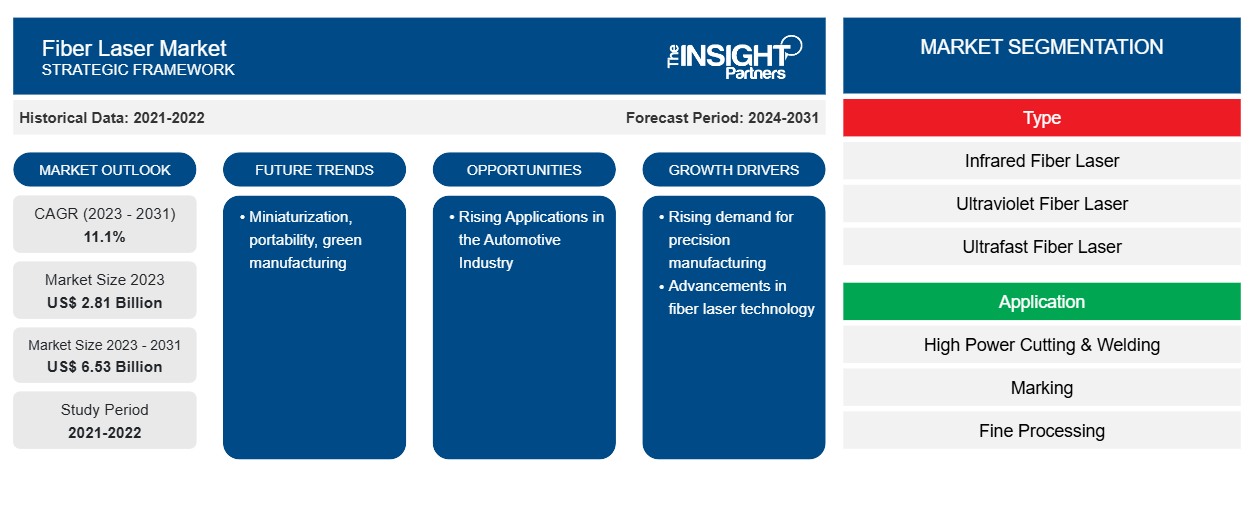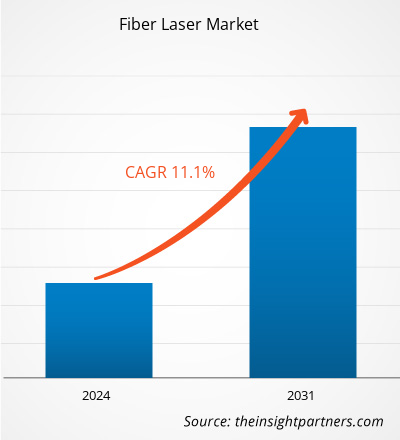Si prevede che la dimensione del mercato dei laser a fibra raggiungerà i 6,53 miliardi di dollari entro il 2031, rispetto ai 2,81 miliardi di dollari del 2023. Si prevede che il mercato registrerà un CAGR dell'11,1% nel periodo 2023-2031. La miniaturizzazione, la portabilità e la produzione ecologica rimarranno probabilmente una tendenza chiave nel mercato.
Analisi di mercato del laser a fibra
Le applicazioni per le macchine per il taglio di materiali ultra-duri si stanno espandendo in numerosi settori, tra cui semiconduttori ed elettronica, estrazione mineraria e difesa. L'integrazione delle tecnologie all'avanguardia, come i laser a fibra, nella macchina per il taglio ultra-duro ha reso possibile tutto ciò. Si prevede che le tecnologie laser a fibra troveranno una preferenza straordinariamente elevata dopo che il loro prezzo scenderà tramite lo sviluppo del prodotto e una maggiore competitività di mercato. Le tecnologie laser a fibra sono riconosciute per essere circa trenta volte più veloci delle macchine a scarica elettrica.
Panoramica del mercato dei laser a fibra
Nel mondo attuale, i laser a fibra sono ampiamente utilizzati. Sono frequentemente utilizzati in contesti industriali per eseguire tagli, marcature, saldature, pulizie, testurizzazioni, forature e molte altre attività, grazie alle diverse lunghezze d'onda che possono produrre. Sono impiegati anche in altri settori, tra cui sanità e telecomunicazioni. Esistono numerose applicazioni per i laser a fibra nel settore manifatturiero. I laser a fibra CW con requisiti di manutenzione bassi o nulli sono ideali per applicazioni specifiche dell'industria pesante in cui efficienza e velocità sono particolarmente cruciali. Ad esempio, i laser CW sono perfetti per il taglio laser, la foratura laser e la saldatura laser. Uno strumento ideale per tagli altamente specializzati in forme complesse è un laser a fibra pulsata. Tali applicazioni stanno guidando la crescita del mercato.
Personalizza questo report in base alle tue esigenze
Riceverai la personalizzazione gratuita di qualsiasi report, comprese parti di questo report, o analisi a livello nazionale, pacchetto dati Excel, oltre a usufruire di grandi offerte e sconti per start-up e università
- Scopri le principali tendenze di mercato in questo rapporto.Questo campione GRATUITO includerà analisi di dati che spaziano dalle tendenze di mercato alle stime e alle previsioni.
Driver e opportunità del mercato laser a fibra
La crescente domanda di produzione di precisione favorisce il mercato
La microlavorazione di caratteristiche fini è ora una componente cruciale della produzione ad alto volume in una varietà di settori, tra cui elettronica di consumo, dispositivi medici e automotive. Al contrario, i laser a fibra sono emersi come standard di settore per la marcatura laser e l'elaborazione macro. Il panorama della produzione è cambiato a seguito del taglio laser, che offre alle aziende maggiore flessibilità, velocità e precisione. Con il continuo progresso della tecnologia, si prevede che il taglio laser avrà un impatto maggiore sul modo in cui la produzione e l'innovazione saranno eseguite in futuro.micromachining is now a crucial component of
Applicazioni in crescita nel settore automobilistico
In termini di tagli precisi e di alta qualità, l'impiego di laser cutter nell'industria automobilistica è stato generalmente considerato efficace. Una moltitudine di materiali può essere tagliata rapidamente ed efficacemente con i laser cutter. Ciò comporta tempi di produzione migliori e costi inferiori. Inoltre, forniscono più uniformità e precisione rispetto alle tecniche di taglio convenzionali, il che può ridurre la quantità di errori e difetti nel prodotto finito. Poiché i tagli precisi consentono l'uso efficace delle materie prime, l'uso di laser cutter può anche aiutare a ridurre al minimo lo spreco di materiale. Grazie alle loro dimensioni ridotte, i laser cutter in fibra possono essere facilmente integrati negli attuali processi di produzione e occupare meno superficie.
Analisi della segmentazione del rapporto di mercato del laser a fibra
I segmenti chiave che hanno contribuito alla derivazione dell'analisi di mercato del laser a fibra sono tipologia e applicazione.
- In base al tipo, il mercato dei laser a fibra è suddiviso in laser a fibra infrarossa, laser a fibra ultravioletta, laser a fibra ultraveloce e laser a fibra visibile. Il segmento dei laser a fibra infrarossa ha detenuto la quota maggiore nel 2023.ultrafast fiber laser, and visible fiber laser. The infrared fiber laser segment held the largest share in 2023.
- In base all'applicazione, il mercato è suddiviso in taglio e saldatura ad alta potenza, marcatura, lavorazione fine e microlavorazione.
Analisi della quota di mercato del laser a fibra per area geografica
L'ambito geografico del rapporto sul mercato dei laser a fibra è suddiviso principalmente in cinque regioni: Nord America, Asia Pacifico, Europa, Medio Oriente e Africa, Sud e Centro America.
L'Asia Pacific detiene una quota significativa del mercato dei laser a fibra nel 2023. La regione ha un importante polo manifatturiero e un'industria automobilistica consolidata. I laser a fibra trovano importanti applicazioni in questi settori per la produzione di precisione, guidando così la crescita nella regione.
Approfondimenti regionali sul mercato dei laser a fibra
Le tendenze regionali e i fattori che influenzano il mercato dei laser a fibra durante il periodo di previsione sono stati ampiamente spiegati dagli analisti di Insight Partners. Questa sezione discute anche i segmenti e la geografia del mercato dei laser a fibra in Nord America, Europa, Asia Pacifico, Medio Oriente e Africa e America meridionale e centrale.

- Ottieni i dati specifici regionali per il mercato laser a fibra
Ambito del rapporto sul mercato dei laser a fibra
| Attributo del report | Dettagli |
|---|---|
| Dimensioni del mercato nel 2023 | 2,81 miliardi di dollari USA |
| Dimensioni del mercato entro il 2031 | 6,53 miliardi di dollari USA |
| CAGR globale (2023-2031) | 11,1% |
| Dati storici | 2021-2022 |
| Periodo di previsione | 2024-2031 |
| Segmenti coperti | Per tipo
|
| Regioni e Paesi coperti | America del Nord
|
| Leader di mercato e profili aziendali chiave |
|
Densità dei player del mercato laser a fibra: comprendere il suo impatto sulle dinamiche aziendali
Il mercato del mercato laser a fibra sta crescendo rapidamente, spinto dalla crescente domanda degli utenti finali dovuta a fattori quali l'evoluzione delle preferenze dei consumatori, i progressi tecnologici e una maggiore consapevolezza dei vantaggi del prodotto. Con l'aumento della domanda, le aziende stanno ampliando le loro offerte, innovando per soddisfare le esigenze dei consumatori e capitalizzando sulle tendenze emergenti, il che alimenta ulteriormente la crescita del mercato.
La densità degli operatori di mercato si riferisce alla distribuzione di aziende o società che operano in un particolare mercato o settore. Indica quanti concorrenti (operatori di mercato) sono presenti in un dato spazio di mercato in relazione alle sue dimensioni o al valore di mercato totale.
Le principali aziende che operano nel mercato dei laser a fibra sono:
- Sistemi in fibra attiva GmbH
- Società di fotonica IPG
- Azienda
- Fotonica convergente
- Coerente, Inc.
- Azienda Jenoptik
Disclaimer : le aziende elencate sopra non sono classificate secondo un ordine particolare.

- Ottieni una panoramica dei principali attori del mercato laser a fibra
Notizie e sviluppi recenti sul mercato dei laser a fibra
Il mercato dei laser a fibra viene valutato raccogliendo dati qualitativi e quantitativi post-ricerca primaria e secondaria, che includono importanti pubblicazioni aziendali, dati associativi e database. Di seguito sono elencati alcuni degli sviluppi nel mercato dei laser a fibra:
- L'azienda high-tech TRUMPF ha acquisito una quota dell'80 percento in Active Fiber Systems GmbH (AFS), un'azienda con sede a Jena, in Germania, specializzata in laser a fibra. AFS sviluppa e produce sistemi laser a impulsi ultracorti e sistemi laser a fibra utilizzati principalmente in ambito scientifico e di ricerca. Oltre alla ricerca di base, i suoi campi di applicazione includono la generazione di luce a lunghezza d'onda estremamente corta con elevata coerenza, imaging biomedico e lavorazione dei materiali. (Fonte: TRUMPF, comunicato stampa, febbraio 2022)
- IPG Photonics Corporation (NASDAQ: IPGP), leader mondiale nella tecnologia laser a fibra, presenterà nuove e innovative soluzioni laser al The Battery Show dal 12 al 14 settembre 2023, a Novi, Michigan, USA. IPG presenterà una nuova sorgente laser Adjustable Mode Beam (AMB) in grado di ottenere un raggio laser monomodale da 3 kW nel nucleo. Una novità assoluta nel settore, questo aumento della potenza monomodale offre miglioramenti senza precedenti in termini di velocità e produttività per la saldatura delle batterie con velocità di saldatura senza spruzzi fino a 2 volte più veloci rispetto a quelle possibili con potenze del nucleo inferiori. (Fonte: IPG Photonics Corporation, comunicato stampa, agosto 2023)
Copertura e risultati del rapporto sul mercato dei laser a fibra
Il rapporto "Dimensioni e previsioni del mercato del laser a fibra (2021-2031)" fornisce un'analisi dettagliata del mercato che copre le seguenti aree:
- Dimensioni e previsioni del mercato dei laser a fibra a livello globale, regionale e nazionale per tutti i principali segmenti di mercato coperti dall'ambito
- Tendenze del mercato dei laser a fibra, nonché dinamiche di mercato come driver, vincoli e opportunità chiave
- Analisi dettagliata delle cinque forze PEST/Porter e SWOT
- Analisi di mercato del laser a fibra che copre le principali tendenze del mercato, il quadro globale e regionale, i principali attori, le normative e i recenti sviluppi del mercato
- Analisi del panorama industriale e della concorrenza che copre la concentrazione del mercato, l'analisi della mappa di calore, i principali attori e gli sviluppi recenti per il mercato dei laser a fibra
- Profili aziendali dettagliati
- Analisi storica (2 anni), anno base, previsione (7 anni) con CAGR
- Analisi PEST e SWOT
- Valore/volume delle dimensioni del mercato - Globale, regionale, nazionale
- Industria e panorama competitivo
- Set di dati Excel



Report Coverage
Revenue forecast, Company Analysis, Industry landscape, Growth factors, and Trends

Segment Covered
This text is related
to segments covered.

Regional Scope
North America, Europe, Asia Pacific, Middle East & Africa, South & Central America

Country Scope
This text is related
to country scope.
Domande frequenti
Asia Pacific dominated the fiber laser market in 2023.
Rising demand for precision manufacturing and advancements in fiber laser technology are expected to drive the fiber laser market.
Miniaturization, portability, and green manufacturing are likely to remain key trends in the market.
Active Fiber Systems GmbH, IPG Photonics Corporation, Fujikura Ltd., Convergent Photonics, Coherent, Inc., Jenoptik AG, Maxphotonics Co,.Ltd, nLIGHT, Inc., TRUMPF GmbH + Co. KG, and Wuhan Raycus Fiber Laser Technologies Co., Ltd. are among the leading payers operating in the fiber laser market.
The fiber laser market size is projected to reach US$ 6.53 billion by 2031
The fiber laser market is expected to register a CAGR of 11.1% during 2023–2031
Trends and growth analysis reports related to Electronics and Semiconductor : READ MORE..
The Insight Partners performs research in 4 major stages: Data Collection & Secondary Research, Primary Research, Data Analysis and Data Triangulation & Final Review.
- Data Collection and Secondary Research:
As a market research and consulting firm operating from a decade, we have published and advised several client across the globe. First step for any study will start with an assessment of currently available data and insights from existing reports. Further, historical and current market information is collected from Investor Presentations, Annual Reports, SEC Filings, etc., and other information related to company’s performance and market positioning are gathered from Paid Databases (Factiva, Hoovers, and Reuters) and various other publications available in public domain.
Several associations trade associates, technical forums, institutes, societies and organization are accessed to gain technical as well as market related insights through their publications such as research papers, blogs and press releases related to the studies are referred to get cues about the market. Further, white papers, journals, magazines, and other news articles published in last 3 years are scrutinized and analyzed to understand the current market trends.
- Primary Research:
The primarily interview analysis comprise of data obtained from industry participants interview and answers to survey questions gathered by in-house primary team.
For primary research, interviews are conducted with industry experts/CEOs/Marketing Managers/VPs/Subject Matter Experts from both demand and supply side to get a 360-degree view of the market. The primary team conducts several interviews based on the complexity of the markets to understand the various market trends and dynamics which makes research more credible and precise.
A typical research interview fulfils the following functions:
- Provides first-hand information on the market size, market trends, growth trends, competitive landscape, and outlook
- Validates and strengthens in-house secondary research findings
- Develops the analysis team’s expertise and market understanding
Primary research involves email interactions and telephone interviews for each market, category, segment, and sub-segment across geographies. The participants who typically take part in such a process include, but are not limited to:
- Industry participants: VPs, business development managers, market intelligence managers and national sales managers
- Outside experts: Valuation experts, research analysts and key opinion leaders specializing in the electronics and semiconductor industry.
Below is the breakup of our primary respondents by company, designation, and region:

Once we receive the confirmation from primary research sources or primary respondents, we finalize the base year market estimation and forecast the data as per the macroeconomic and microeconomic factors assessed during data collection.
- Data Analysis:
Once data is validated through both secondary as well as primary respondents, we finalize the market estimations by hypothesis formulation and factor analysis at regional and country level.
- Macro-Economic Factor Analysis:
We analyse macroeconomic indicators such the gross domestic product (GDP), increase in the demand for goods and services across industries, technological advancement, regional economic growth, governmental policies, the influence of COVID-19, PEST analysis, and other aspects. This analysis aids in setting benchmarks for various nations/regions and approximating market splits. Additionally, the general trend of the aforementioned components aid in determining the market's development possibilities.
- Country Level Data:
Various factors that are especially aligned to the country are taken into account to determine the market size for a certain area and country, including the presence of vendors, such as headquarters and offices, the country's GDP, demand patterns, and industry growth. To comprehend the market dynamics for the nation, a number of growth variables, inhibitors, application areas, and current market trends are researched. The aforementioned elements aid in determining the country's overall market's growth potential.
- Company Profile:
The “Table of Contents” is formulated by listing and analyzing more than 25 - 30 companies operating in the market ecosystem across geographies. However, we profile only 10 companies as a standard practice in our syndicate reports. These 10 companies comprise leading, emerging, and regional players. Nonetheless, our analysis is not restricted to the 10 listed companies, we also analyze other companies present in the market to develop a holistic view and understand the prevailing trends. The “Company Profiles” section in the report covers key facts, business description, products & services, financial information, SWOT analysis, and key developments. The financial information presented is extracted from the annual reports and official documents of the publicly listed companies. Upon collecting the information for the sections of respective companies, we verify them via various primary sources and then compile the data in respective company profiles. The company level information helps us in deriving the base number as well as in forecasting the market size.
- Developing Base Number:
Aggregation of sales statistics (2020-2022) and macro-economic factor, and other secondary and primary research insights are utilized to arrive at base number and related market shares for 2022. The data gaps are identified in this step and relevant market data is analyzed, collected from paid primary interviews or databases. On finalizing the base year market size, forecasts are developed on the basis of macro-economic, industry and market growth factors and company level analysis.
- Data Triangulation and Final Review:
The market findings and base year market size calculations are validated from supply as well as demand side. Demand side validations are based on macro-economic factor analysis and benchmarks for respective regions and countries. In case of supply side validations, revenues of major companies are estimated (in case not available) based on industry benchmark, approximate number of employees, product portfolio, and primary interviews revenues are gathered. Further revenue from target product/service segment is assessed to avoid overshooting of market statistics. In case of heavy deviations between supply and demand side values, all thes steps are repeated to achieve synchronization.
We follow an iterative model, wherein we share our research findings with Subject Matter Experts (SME’s) and Key Opinion Leaders (KOLs) until consensus view of the market is not formulated – this model negates any drastic deviation in the opinions of experts. Only validated and universally acceptable research findings are quoted in our reports.
We have important check points that we use to validate our research findings – which we call – data triangulation, where we validate the information, we generate from secondary sources with primary interviews and then we re-validate with our internal data bases and Subject matter experts. This comprehensive model enables us to deliver high quality, reliable data in shortest possible time.


 Ottieni un campione gratuito per questo repot
Ottieni un campione gratuito per questo repot